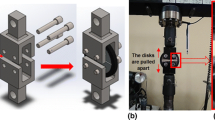Conclusions
-
1.
Small deformations (up to 25%) during HTMT lead to substantial internal stresses — compressive (axial 35 kgf/mm2 and tangential 27 kgf/mm2) on the outer surface and tensile (axial 90 kgf/mm2 and tangential 87 kgf/mm2) on the inner surface and also to uneven microhardness (H 500–825) through the section.
-
2.
Increasing the deformation to 46% reduces the amplitude of compressive (axial up to 12 kgf/mm2 and tangential to zero) internal stresses at the outer surface and also tensile (axial up to 30 kgf/mm2 and tangential up to 45 kgf/mm2) internal stresses at the inner surface.
Similar content being viewed by others
Literature cited
I. A. Birger, Residual Stresses [in Russian], Mashgiz, Moscow (1963).
M. M. Kobrin and L. I. Dekhtyar', Determining Internal Stresses in Cylindrical Parts [in Russian], Mashinostroenie, Moscow (1965).
Additional information
All-Union Scientific-Research Pipe Institute, Dnepropetrovsk. Translated from Metallovedenie i Termicheskaya Obrabotka Metallov, No. 12, pp. 41–43, December, 1979.
Rights and permissions
About this article
Cite this article
Pryadko, E.I., Radchenko, R.P. & Verkhovskii, S.N. Investigation of stresses in high-strength pipe. Met Sci Heat Treat 21, 943–945 (1979). https://doi.org/10.1007/BF00706634
Issue Date:
DOI: https://doi.org/10.1007/BF00706634




